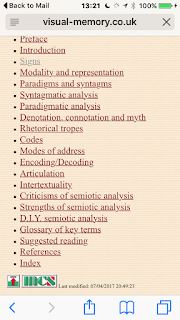http://visual-memory.co.uk/daniel/Documents/S4B/sem02.html
'
Homo significans - meaning-makers. Distinctively, we make meanings through our creation and interpretation of 'signs'.'
' 'we think only in signs'
(Peirce 1931-58, 2.302). Signs take the form of words,
images, sounds, odours, flavours, acts or objects, but such things have no intrinsic meaning and become signs only when we invest them with meaning.'
linguist Ferdinand de Saussure and the philosopher Charles Sanders Peirce
'Saussure offered a 'dyadic' or two-part model of the sign. He defined a sign as being composed of:
a 'signifier' (signifiant) - the form which the sign takes; and
the 'signified' (signifié) - the concept it represents. '
'The Representamen: the form which the sign takes (not necessarily material);
An Interpretant: not an interpreter but rather the sense made of the sign;
An Object: to which the sign refers.'
'
| 'Symbol/symbolic: a mode in which the signifier does not resemble the signified but which is fundamentally arbitrary or purely conventional - so that the relationship must be learnt: e.g. language in general (plus specific languages, alphabetical letters, punctuation marks, words, phrases and sentences), numbers, morse code, traffic lights, national flags; |
| Icon/iconic: a mode in which the signifier is perceived as resembling or imitating the signified (recognizably looking, sounding, feeling, tasting or smelling like it) - being similar in possessing some of its qualities: e.g. a portrait, a cartoon, a scale-model, onomatopoeia, metaphors, 'realistic' sounds in 'programme music', sound effects in radio drama, a dubbed film soundtrack, imitative gestures; |
| Index/indexical: a mode in which the signifier is not arbitrary but is directly connected in some way (physically or causally) to the signified - this link can be observed or inferred: e.g. 'natural signs' (smoke, thunder, footprints, echoes, non-synthetic odours and flavours), medical symptoms (pain, a rash, pulse-rate), measuring instruments (weathercock, thermometer, clock, spirit-level), 'signals' (a knock on a door, a phone ringing), pointers (a pointing 'index' finger, a directional signpost), recordings (a photograph, a film, video or television shot, an audio-recorded voice), personal 'trademarks' (handwriting, catchphrase) and indexical words ('that', 'this', 'here', 'there').' |


No comments:
Post a Comment